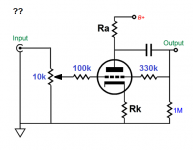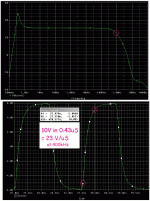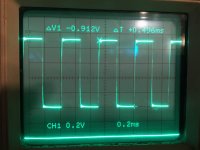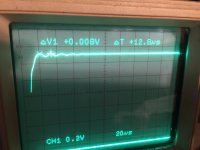I am not sure I understand. Are you saying this is good or suggesting a change.
This is good, especially if the source has non-linear output impedance, that is always the case. But real input resistance will be limited by a loudness control pot.
People seem to really like the sound of the line stage in the McIntosh preamps.
What about slew rate limit?
Eh, not necessarily (or at least, not enough to matter)
Exactly. The cap on input does not sound, unlike before control grids of no feedback output stages.
However, since it is loaded on a bootstrapped resistor, you should remember that input impedance varies with open loop gain that is non-linear. "No free cheese to mice, except in a mouse trap!"
What about slew rate limit?
For the McIntosh design?
It has buffers after the stage (opamps). If opamps isn't his thing add any buffer with adequate current to drive any capacitance.
Has anyone done a two stage with dissimilar triodes (with or without the follower)? In certain situations might there be a use for a high mu low current first stage and a low mu higher current second stage? The first stage gets your gain early and low mu second stage has more input signal swing room. Second stage also presents less Miller to the first stage. If the subsequent circuitry has a high enough Zin the higher current second stage may be able to drive a bit more capacitance without a follower being strictly necessary.
Am I off in the weeds with this idea?
Am I off in the weeds with this idea?
BTW, all my annoying questions come from the fact that I am looking into "Junk box" projects. I have a handful of SE OPT, a couple pair of PA speaker line xformers, assorted multi-element tubes (e.g. 6GV8) a few 12AY7 and 6N1P and a boat load of 12AX7 and 12AU7. Thus the interest in utility preamps (and one for my KT PA) and an input section for an integrated 6GV8 SE akin to the RH84 in pentode mode.
...What about slew rate limit?
...one weak triode running Miller capacitance of the second one plus 47 pF.
Just counting on thumbs: that first stage is 2X faster than a '741. BUT the second stage has gain near 50, so the output (where we care) is 100X faster than a '741. Say 50V/uS. By Jung's old studies, 1V/uS per Vpeak is a good minimum for audio. We are not likely to be close to 50V peak here.
It might be illuminating to build or model it, but I'm too tired to do it today.
I would note that Mac are the sort of folks who would bench-test with sig-gen and 'scope, and turn the knobs way past the audio band. Even a H-P 200AB would give HIGH-level 40KHz sine, and that was old junk at the time they put a 150V PNP in a tube amp. If the thing went slewy, they would have noticed.
If all your program sources have low output impedance (CD players, DACs, phono preamps with buffered outputs) then why is a super-high input impedance necessary for your line stage?
If all your sources have output impedances of about 1k ohms or lower, you could do a single 'anode follower' stage with the output from the triode plate brought back to the triode grid (input). Use a large enough series resistor for the negative feedback voltage divider, maybe 100k. Then use a 10k volume control pot before the grid (and series R).
Now as you adjust the pot, it's not changing the value of the series resistor by that much, is it?
Good 0.5W metal film resistors shouldn't be overly noisy at line level, right?
I've attached a schematic of what I mean. As long as all sources are low impedance, would there be any serious disadvantages to this?
--
If all your sources have output impedances of about 1k ohms or lower, you could do a single 'anode follower' stage with the output from the triode plate brought back to the triode grid (input). Use a large enough series resistor for the negative feedback voltage divider, maybe 100k. Then use a 10k volume control pot before the grid (and series R).
Now as you adjust the pot, it's not changing the value of the series resistor by that much, is it?
Good 0.5W metal film resistors shouldn't be overly noisy at line level, right?
I've attached a schematic of what I mean. As long as all sources are low impedance, would there be any serious disadvantages to this?
--
Attachments
Just counting on thumbs: that first stage is 2X faster than a '741. BUT the second stage has gain near 50, so the output (where we care) is 100X faster than a '741. Say 50V/uS. By Jung's old studies, 1V/uS per Vpeak is a good minimum for audio. We are not likely to be close to 50V peak here.
It might be illuminating to build or model it, but I'm too tired to do it today.
I would note that Mac are the sort of folks who would bench-test with sig-gen and 'scope, and turn the knobs way past the audio band. Even a H-P 200AB would give HIGH-level 40KHz sine, and that was old junk at the time they put a 150V PNP in a tube amp. If the thing went slewy, they would have noticed.
1 mA/150 pF is about 6V /uS, also not quite symmetric. It was considered as fine then, but not according to my modern standards.
A stab at doing the utility preamp using CCDA principle. Note that the Ceramic/Tape switch is not shown. Also the final stage load resistors don't match but idle current does. Given the slightly different bias layout I expect that some diddling with R values will be needed at build time.
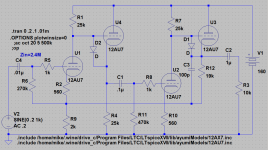
The 6GV8 integrated amp idea not showing the volume control. This one does not need as high of Zin and I don't think a particularly low driving Z into the 6GV8 triode is needed either so I did not bother with a follower. It is easy enough to add if needed .
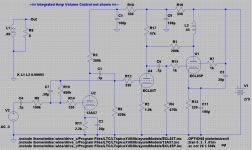

The 6GV8 integrated amp idea not showing the volume control. This one does not need as high of Zin and I don't think a particularly low driving Z into the 6GV8 triode is needed either so I did not bother with a follower. It is easy enough to add if needed .

1 mA/150 pF is about 6V /uS, also not quite symmetric. It was considered as fine then, but not according to my modern standards.
OK, accepting 6V/us at the *second grid*, then this is gained-up by the second triode about 25 times, to make 150V/uS *at the output*. (Which is where we care.)
It is possible, but difficult, to make a triode amp "slew". The very heavy NFB here (~~40dB) does shift the closed-loop pole up while not helping slew rate.
In "simulation", I see ~~1MHz closed-loop bandwidth(!). Fed hard with 1Vpk 400KHz square-wave I get 20V/uS, not "slew", but simple exponential. It is bandwidth-limited, NOT slew limited.
Pushing harder, FAR beyond what a preamp should be expected to do, I do see slew (and your predicted asymmetry!) at levels 5X higher, 30V peak. 117V/us rise, exponential fall. Indeed a 30Vpk 400KHz square-wave is ugly. And also nothing I would ever want coming through a hi-fi preamp.
BTW: the two 47pFd caps and the nominal C of the tubes *appear* to be non-optimum out around 10MHz, throwing tall spikes. Making the C in the NFB loop 10pFd smooths it out. I don't trust that answer: I did not model the many layout strays or any cable on the output.
Attachments
Thank you from McIntosh. Your simulation rehabilitated them. 
Here is my whole power amp for comparison, from the secondary of output transformer loaded on 8 Ohm resistors. 10:1 probe. First picture: observing triangle, second picture: observing ringing.
Here is my whole power amp for comparison, from the secondary of output transformer loaded on 8 Ohm resistors. 10:1 probe. First picture: observing triangle, second picture: observing ringing.
Attachments
Wow I wasn't going to do any simulations so thank you PRR!!
I figured the McIntosh circuit is plenty capable for audio purposes. I don't think they are slouches over there in Binghamton NY and many of my friends love the sound that comes out of that preamp. It's much too pricey for my price range but I admit it sounds good. And it's a 12AX7 too (gasp)


I figured the McIntosh circuit is plenty capable for audio purposes. I don't think they are slouches over there in Binghamton NY and many of my friends love the sound that comes out of that preamp. It's much too pricey for my price range but I admit it sounds good. And it's a 12AX7 too (gasp)
I figured the McIntosh circuit is plenty capable for audio purposes. I don't think they are slouches over there in Binghamton NY and many of my friends love the sound that comes out of that preamp. It's much too pricey for my price range but I admit it sounds good. And it's a 12AX7 too (gasp)
I would use instead 6N1P or 6SN7 on higher currents. Anyway it would be an overkill for 5.5 times amplification factor.
I agree, I really like the 6SN7.I would use instead 6N1P or 6SN7 on higher currents. Anyway it would be an overkill for 5.5 times amplification factor.
I personally have no need for extra gain, my amps are driven to full power by the sources directly.
Basically I figured I would toss it in the mix of ideas because he said he had 12AX7's and it was different than what has been suggested.
- Status
- This old topic is closed. If you want to reopen this topic, contact a moderator using the "Report Post" button.
- Home
- Amplifiers
- Tubes / Valves
- Line stage feedback strategies
